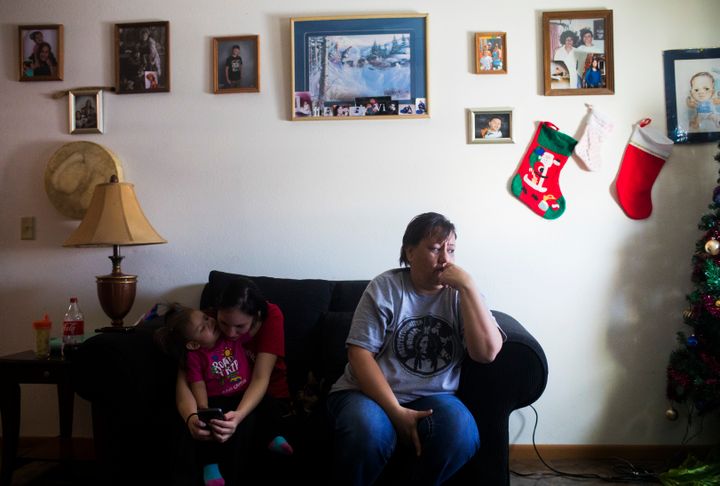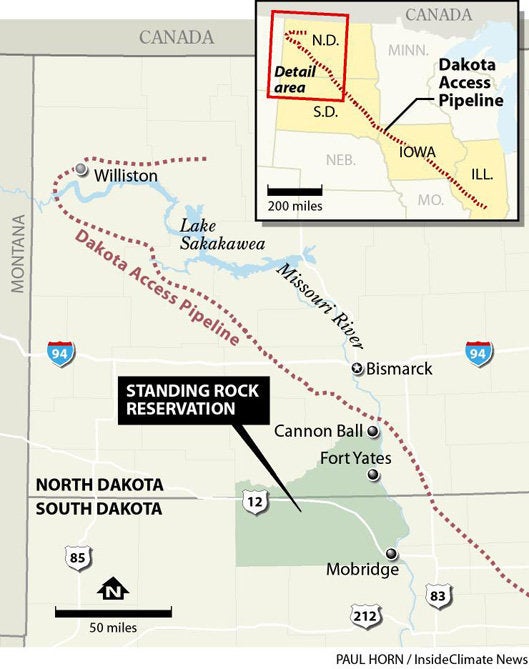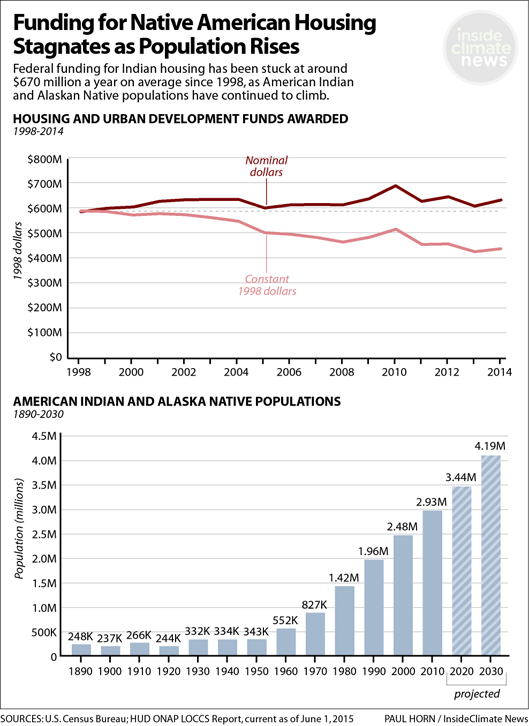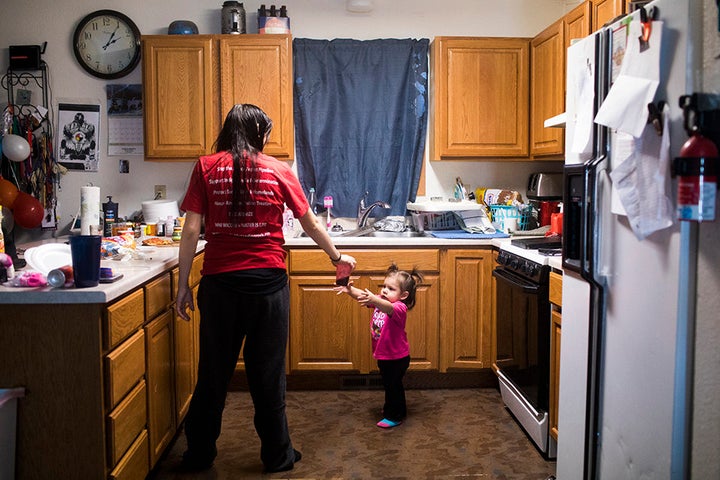
This story was co-published with InsideClimate News.
Oil is now in the Dakota Access pipeline under the Missouri River, half a mile north of the Standing Rock Sioux reservation in North Dakota. The pipeline will soon begin operating despite a year of sometimes violent protests by thousands of native and non-native demonstrators, who fear a spill from the pipeline polluting the reservation’s water supply. The fight ended abruptly when, as one of his first acts, President Donald Trump reversed an order from his predecessor, President Barack Obama, and canceled a new, more thorough environmental impact study by the Army Corps of Engineers.
Pipeline opponents had high expectations of stopping the pipeline, but they were not surprised by their failure. “Since Columbus ‘discovered’ America, Native Americans have had to endure the worst of the worst,” said Steven Willard, a resident of the Standing Rock reservation living in Fort Yates, downstream from the pipeline. “This is just going to be another object thrown at us that we will have to find a way to endure.”
Every day is a test of endurance on the reservation, which encompasses 3,600 square miles of windswept prairie in North and South Dakota. Freezing in winter, baking in summer, the reservation’s residents brave the elements in clusters of trailer parks and prefabricated homes. Some 40 percent of its 8,200 people live below the poverty line. Like other Native American communities, Standing Rock suffers from high rates of unemployment, alcoholism and suicide. The health care system is a shambles, and housing is so scarce that multiple families often cram into a single dwelling.
The protests over the pipeline, which included a contingent of military veterans, threw the dire living conditions on reservations throughout the country into high relief. “It is much more than just about a pipeline,” said former North Dakota Sen. Byron Dorgan, who was chairman of the Senate Committee on Indian Affairs before leaving office in 2011. “They were promised health care, housing, law enforcement and a good education. Much of it was written in treaties and it hasn’t been delivered.”

Standing Rock’s supporters fear interest in improving conditions for the tribe is waning with the end of the pipeline battle. Already one project — construction of a new health clinic in Fort Yates that would combine modern and traditional Lakota medicine — is in trouble. The health center quickly raised $300,000 during the uprising; since it ended, the flow of new funds has slowed to a trickle.
The $3.8 billion pipeline will pump crude oil from North Dakota to Illinois, and the drive to halt it was the most disruptive event to hit Fort Yates (pop. 195) in decades. Sonja and Steven Willard, who live at the intersection of streets named Akicita and Cante — Lakota for “warrior” and “heart” — enthusiastically pitched in. They joined the prayer circles and helped sort supplies donated to demonstrators camped out at Oceti Sakowin, the main protest camp near Cannon Ball. Their son Ghavin, a lanky 16-year-old, served as a scout, riding on horseback along the pipeline’s route, keeping an eye on the construction crews as they advanced toward the Missouri River.
The Willards and their neighbors hoped they had been given an indefinite reprieve when Obama ordered the new environmental study on Dec. 4. Trump’s quick abrogation of Obama’s order was a shock. Though demonstrations continued — hundreds of protesters recently marched from the Washington headquarters of the Army Corps of Engineers to the Trump International Hotel, where they erected a teepee — the Willards folded their tent.
“I know there are still people out there fighting,” said Sonja, a square-jawed 46-year-old Hunkpapa Lakota, shortly after Trump issued his order, “but from my point of view it is over and done with. My hope was lost when Trump got in. Maybe I’m giving up too soon, but I feel no one can get around him, he is too powerful.”
Said a bitter Dave Archambault II, chairman of the Standing Rock tribe: “This president is not trying to make America great again.” He is “trying to abuse American Indians again.”
With the pipeline now nearly complete, the Willard family doesn’t go near the construction site. What they once viewed as a symbol of hope they now see as yet another depressing example of defeat. “I just stay away,” Sonja said. “I do not want to see what they are doing.”
Members of the Standing Rock tribe brought to the pipeline controversy bitter memories of their last losing battle against the Army Corps of Engineers. That was in the early 1960s, when the Corps built the Oahe Dam on the Missouri river near Pierre, S.D., creating Lake Oahe, a huge body of water extending more than 200 miles upstream almost to Bismarck, N.D. The lake flooded 56,000 acres of Standing Rock’s farm and woodlands. Sonja Willard remembers tribal elders recounting how their homes were set on fire before the reservoir filled with water.
Lake Oahe shrank further what was once a Native American empire. Before Europeans arrived in North America, the Lakota, Dakota, and Nakota nations, collectively known as the Sioux, lived across the Great Plains, including much of what is now North and South Dakota, plus parts of Nebraska, Iowa, and Minnesota.
The Sioux retained a small fraction of this land, which included the area where the pipeline now passes under Lake Oahe, in an 1851 treaty with the U.S. government. In 1868, the government moved the Lakota, Dakota and Nakota tribes onto a still smaller area—The Great Sioux Reservation—then took much of that land away less than a decade later when gold was discovered in the Black Hills.
“A more ripe and rank case of dishonorable dealings will never, in all probability, be found in our history,” a federal court said of the government’s treatment of the Sioux in 1979.

Today, the Sioux live on a small fraction of their ancestral land and are spread across 25 reservations and reserves, remote communities in the U.S. and Canada that are rife with poor housing and health problems.
The Willards and other members of the Standing Rock tribe are several times more likely to die from alcoholism, diabetes or suicide than other Americans. Life expectancy on reservations in the Great Plains region— an area that includes North Dakota, South Dakota, Nebraska, and Iowa—is 67, more than 10 years lower than the national average.
Sonja, a recovering alcoholic, said her children have seen a lot. She knows the pain of watching friends and family members die from cirrhosis. Her son is a heroin addict and several of his friends have died from overdoses.
Willard has raised six children on the Standing Rock reservation. A seventh child, who was raised off the reservation, stopped coming after a few visits. “He was scared by what he saw,” Willard said.
Reservation life, according to studies by Congress and various federal agencies, is a society where the social safety net that protects other Americans has broken down.
For example, the Indian Health Services, the division of the Department of the Interior charged with providing health care to Native Americans, funds it at an abysmal rate: half the rate the federal government funds care for federal prisoners, and less than one-third the rate of Medicare beneficiaries, according to a 2010 report by the Senate Committee on Indian Affairs.
The result has been a series of tragedies. In December 2015, IHS shut down the emergency room at a hospital on the Rosebud Reservation, 200 miles south of Standing Rock, due to unsafe conditions. During the facility’s seven-month closure at least five people died while being transferred to other hospitals more than an hour’s drive away. “What we found is simply horrifying and unacceptable,” Republican Sen. John Barrasso, a physician and recent chairman of the Senate Committee on Indian Affairs, said in a hearing last February. “In my view the information provided to this committee and witnessed firsthand can be summed up in one word, ‘malpractice.’”

The only hospital on the Standing Rock reservation is a 12-bed facility in Fort Yates. Dr. Rupa Marya, a professor at the University of California at San Francisco medical school, which is backing construction of the reservation’s new medical clinic, points out that the current facility has no intensive care unit and no ultrasound machine, which means that pregnant women often have to seek care elsewhere. One tiny medical facility for 8,200 people scattered across hundreds of miles is far from adequate. “There might be a five-month wait to see an ear, nose and throat specialist,” Marya said. The facility, she added, has limited “resources for technological equipment, labs, that kind of stuff.”
UCSF’s Do No Harm Coalition is partnering with Lakota health care professionals to raise $1 million to build and staff a clinic that would supplement care provided by IHS. “The hope is to leave the reservation and the people there with greater access to health care that is culturally appropriate,” Marya said. “We are working with local Lakota physicians and tribal healers to develop a curriculum of decolonized medicine, a place where indigenous perspectives on health and indigenous practices and indigenous practitioners will be at the forefront.”
One impetus behind the clinic project is the history of mistreatment at IHS facilities. An independent study by Native American physician Dr. Connie Pinkerton-Uri in 1974 estimated that one in four American Indian women had been sterilized at IHS clinics without their consent. Two years later, the U.S. General Accounting Office (now the Government Accountability Office) found that 3,406 American Indian women were sterilized between 1973 and 1976 in four of the 12 IHS regions, including what is now the Great Plains region. Of the sterilizations reviewed in detail, consent procedures were “generally not in compliance” with IHS regulations, the agency concluded.
The Do No Harm Coalition has received more than $300,000 in donations thus far, including $50,000 from San Francisco 49ers quarterback Colin Kaepernick, an outspoken critic of the ongoing oppression of people of color in the United States.
In recent months, however, as the final easement for the Dakota Access pipeline was granted and construction was completed, donations to the clinic have slowed. Marya said most of the money so far has been from individuals, and she is now seeking funds from foundations and other traditional donors.
Former Sen. Dorgan said part of the public health crisis is related to inadequate law enforcement. At one point, he said, the entire Standing Rock reservation, an area larger than the state of Delaware, was served by nine Bureau of Indian Affairs police officers. He recalled holding a hearing a decade ago at the Spirit Lake reservation in North Dakota, and taking testimony from the head of the child welfare office. “She said, ‘I have a stack 2 feet high on the floor beside my desk of complaints of child sexual abuse, and they have not even been investigated because we don’t have the resources.’” Dorgan said the social worker broke down weeping, and soon after, quit her job.
Housing, however, is where the inequality between Native American country and the rest of America is most stark. A 2003 report by the U.S. Commission on Civil Rights, a bipartisan commission charged with overseeing civil rights enforcement in the U.S, produced some stunning statistics: Roughly 90,000 Native American families were homeless, more than 30 percent of Native American housing was overcrowded, 20 percent of Native American homes lacked full indoor plumbing, and overall, 40 percent of Native American housing was substandard.

In January, the Department of Housing and Urban Development reported that federal funding for Native American housing has stagnated at roughly $667 million a year since 1998. Accounting for inflation, HUD would now need to spend nearly $1 billion a year to have the same purchasing power as it did in 1998.
Pamala Silas, executive director of the National American Indian Housing Council, a nonprofit advocacy group, says tribes can’t keep up. “Now, instead of developing new units, the money is being utilized to maintain and to subsidize existing units,” Silas said. “The dollar isn’t going as far. In the meantime, you have more people hitting the poverty levels, you have a growing population and an inadequate resource to get ahead of it.”
If President Trump’s budget proposal becomes reality, the situation may be about to get much worse. A draft HUD budget proposal leaked last month suggests funds allocated for Native American housing would be cut by $150 million, or 23 percent.
Fort Yates offers a microcosm of the housing problem affecting Native American communities across the country. Ninety percent of families there live in public housing. While there is no shortage of land on the open prairie surrounding Fort Yates, the reservation faces a housing crisis. Waiting lists for public housing are years long. Stories of homes housing a dozen or more relatives are common.
Sonja Willard had to wait nine years to get into public housing. Her 20-year-old daughter Annika, who is pregnant with her second child, is approximately 30th on the list for a single-bedroom home, a wait Sonja said could take another 15 years. Annika, however, was recently able to move out of her mother’s home when she quit her job and enrolled full time at Sitting Bull College in Fort Yates, which provided her with a three-bedroom house.
Sonja and Steven Willard now live in a comfortable four-bedroom home and both have steady jobs. She works for the tribe’s gaming commission, while he monitors water purification equipment at the tribe’s water treatment plant. Yet even for middle class families like the Willards, buying a home is usually out of the question.
Tribal council member and former tribal planner Chad Harrison tried unsuccessfully for a year and a half to get a mortgage. Banks in Bismarck wouldn’t lend to him because the home he sought to buy was on reservation land, Harrison said.
“I was in a position to go after a traditional loan and there was just roadblock after roadblock,” Harrison said. “It’s been frustrating to say the least.”
Financial institutions are reluctant to grant mortgages on Native American land because the land is often held in trust by the federal government and typically can’t be used as collateral in a foreclosure. Further, tribal laws often require disputes between banks and mortgage holders to be settled in tribal court, where an outside financial institution would likely be at a disadvantage.
Eventually, Harrison gave up on securing a mortgage and took out a personal loan, at a roughly 2 percent higher interest rate, and purchased the home in November.
He is now working to set up a credit union on the reservation, partnering with other tribes to come up with the necessary capital.
The opening of the pipeline adds one more worry to a people who live worried lives. Through Steven’s work at Standing Rock’s aging and soon-to-be-replaced water treatment plant, the Willards have an intimate understanding of just how fragile access to clean drinking water can be.
As the sun sets over rolling, snow-covered hills to the west and the Missouri’s icy waters to the east, Sonja struggles to come to terms with what she would do if oil from the pipeline polluted Standing Rock’s water supply.
“This is my home,” she said. “This is my children’s home, my grandchildren’s home, I’d be scared to leave.”

Phil McKenna’s reporting and Cassi Alexandra’s photography for this story were supported with funding from the Economic Hardship Reporting Project.
